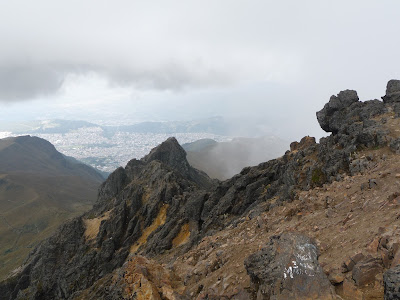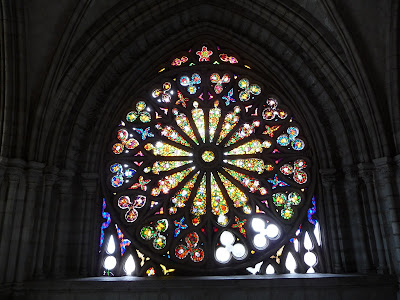 |
| Papagayo |
At the ranch we were met by our guide Diego and Swiss chap called Elia who had tried to climb Cotopaxi the night before, but been turned back by a massive fall of new snow - this didn´t bode well for us- but what the hell. we´ve climbed in Scottish winter...
After some general faffing around, we were taken to the climbing store, where we sorted through various vintage equipment to find something that vaguely fitted - thank god we had brought our own cold weather clothing! Suitably equipped, we headed for Cotopaxi with a stop at Machachi to pick up the food.
Arriving at Cotopaxi, you drive up a massive hill of mud to reach a car park just below the hut and start of the snowline. Given that this was a Sunday, there were hundreds of Ecuadoreans at the car park doing some sightseeing and taking the short walk to the hut to buy a hot chocolate. Not that there was much to see, the entire volcano was enveloped in dense cloud.
 |
| View from Cotopaxi Hut |
 |
| Cotopaxi Hut |
At the hut Diego cooked for us and we drank litres of tea, chatting with Elia, before heading for bed in bunks on the drafty first floor to try and grab some sleep before the 2am start. The hut had a guardian, like those in the alps, but that was pretty much wear the similarities ended. Compared with European Refuges, it was pretty basic, aside from a few soft drinks, there was no food to be had, you did your own cooking and there were no blankets or heating. We slept in our clothes and were both warm enough in spite of the drafts.
The next morning we ventured out after breakfast into miserable morning, visibility was poor and there was a strong wind blowing fine ice crystals at a horizontal angle. We climbed switchbacks for about an hour until the start of the glacier proper, here we stopped to rope up and the first group turned back. By this stage we were all coated in a stiff layer of ice about half a cm thick. We put on our crampons, roped up and persuaded Diego to continue. From here we climbed up through a combination of switch backs and traverses with the route completely obscured by the fresh snow. From this point it became clear that Diego was having difficulty finding the route, he stopped a couple of times and conferred with another guide and we rerouted, taking the lead of a new group of 7 formed from the two remaining groups of climbers.
 |
| Covered in ice at 5300m |
About half an hour later, we reached an area of complex glacial terrain, visibility diminished further and we became surrounded by a huge number of crevasses and seracs. Diego and the guide from the other group now set about exploring the terrain, trying to find a way through. When they started flagged wands along our route, it became clear that they were unsure of the path. To their credit, they tried a number of different route to get through before telling us that a key snow bridge had collapsed under the weight of the new snow. Much to our disappointment we took a couple of pictures including one of Elia with his frizbee (He plays for an Ultimate Frizbee Team in Switzerland) we turned and headed back, following our footprints back down the volcano. We had reached 5300 metres, about 500 metres off the summit.
 |
| Diego, Me, Kirsty and Elia |
Back at the car park it was raining hard and when we discovered that the windscreen wiper on the drivers side of our aging Land Cruiser, didn´t work. After a few minutes of trying to drive with his head sticking out of the side window, it became clear that this technique wasn´t going to work in the long term. So we pulled over and Elia and I relinquished out boot laces which Diego tied to the offending wiper, one lace coming back through his side window, held in his left hand, the other feeding through the passenger window held by Elia. Diego now drove one handed, whilst he and Elia took turns pulling their lace to drag the broken wiper back and forth across the windscreen. This worked quite well until Elia fell asleep.
At Papagayo we stayed the night and were still weighing up whether the weather would be good enough attempt Chimborazo the next day when we waved Elia off. After looking at as many weather websites as we could find, all of which uniformly predicted poor weather with more snow over the coming week, we decided what the hell and confirmed with Diego to make an attempt the next day.
The drive to Chimborazo was much longer than to Cotopaxi. We kept our fingers crossed as the cloud cleared and the pressure rose. As we neared Chimborazo the cloud cleared enough to give us a lopsided view of the summit - promising.
We parked at the lower hut, had lunch and walked up to the Whymper hut, which was only a couple of hundred metres above at 5000m. Both huts were much nicer than the one at Cotopaxi and we both felt good on the short walk to 5000m. At the hut there was only one other party, another Swiss guy called Vincent, who had also been at Cotopaxi with us, and his guide.
 |
| Chimborazo |


By the time we had finished dinner, the weather had improved dramatically and leaving the hut we were greeted with a clear view of the first summit high above us.


It was a cloudless night, and we started our climb under a canopy of stars. Leaving behind the other party, we set off a good pace and quickly passed them as we snake through the moraine to join the left hand side of the glacier under the rocky pinnacle of the Castle. Here the glacier was covered in a fine layer of dust and rocks from the pinnacles above. From here we climbed up onto the shoulder leading to the first summit peak, following a smooth dirt ridge to meet the snow line above. The snow slope stretched away beyond us, its muted outline visible for a few hundred metres ahead under the glow of the constellations above.
We began the monotonous trudge up the slope, Diego leading, rope back to Kirsty and finally to me at 3 metre intervals. After about half an hour, Kirsty started to slow, so we stopped to rest, continuing, she started to feel sick, so we stopped again and rested. She had felt sick on our climb of Mont Blanc, but we had continued and it had passed. I felt great and we had both acclimatised well having spend roughly half of the last month above 4000m, with a couple of visits to 5000 plus. Kirsty wanted to go on, so Deigo and I split the contents of her rucksack and we continued for a while walking about 50m at a time and stopping for 5 mins at each interval. Eventually we were passed by the other group, who wished us well and continued towards the summit.
The altitude sickness wasn´t lessening and she started to complain of dizziness, I looked at her face and it was completely drained of colour. We were at 5850 according to my watch, with another couple hours to make the first summit and no sign of her sickness abating I decided to turn us round. Kirsty was upset and few tears were shed before we started our descent.
The descent proved painfully slow, I led with Diego keeping Kirsty on a short rope from behind. Even on the short rope, Kirsty kept falling over, it didn´t help that it was still very dark. The sickness didn´t lessen as we lost height either and as we got lower and the sun began to rise I saw Kirsty´s face in the light of day- it was completely ashen and her lips were grey. When we finally arrived back at the hut, I we got a hot sweet drink down her, followed by a coke and she started to feel a little better. By the time we got back to the car park, some colour had returned, but she was just desperately gutted to have had to turn back.
 |
| Shadow of Chimborazo in the clouds below |
Our consolation came when we were rewarded with some great views of Chimborazo and the surrounding mountains, including Cotopaxi, which we saw for the first time as we drove away.
 |
| Cotopaxi in the distance |
 |
| The Altar |
The will be other mountains - there´s only one Kirsty.










































